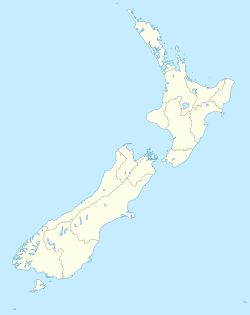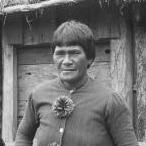Little Barrier Island facts for kids
|
Māori: Te Hauturu-o-Toi
Nickname: Hauturu
|
|
|---|---|
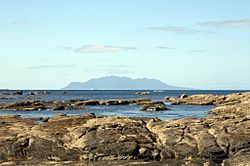
View from the mainland
|
|
| Geography | |
| Location | Hauraki Gulf, Auckland Region |
| Coordinates | 36°11′57″S 175°04′53″E / 36.1991°S 175.0814°E |
| Area | 28.17 km2 (10.88 sq mi) |
| Length | 7.5 km (4.66 mi) |
| Width | 5.5 km (3.42 mi) |
| Highest elevation | 722 m (2,369 ft) |
| Highest point | Mount Hauturu |
| Administration | |
| Demographics | |
| Population | No permanent inhabitants |
| Additional information | |
| Wildlife sanctuary | |
Little Barrier Island, also called Hauturu in Māori, is a special island off the northeastern coast of New Zealand's North Island. Its full Māori name is Te Hauturu-o-Toi, which means "the resting place of lingering breezes."
This island is about 80 kilometers (50 miles) north of Auckland. It is separated from the mainland by the Jellicoe Channel. To its east is the larger Great Barrier Island. These two islands protect the Hauraki Gulf from many storms coming from the Pacific Ocean.
Māori people first settled on Little Barrier Island between 1350 and 1650. The New Zealand government made the island a wildlife sanctuary in 1897. Since then, only a few rangers live there, and access is limited. The island is known as "the most intact native ecosystem in New Zealand." However, some unwanted plants and animals were brought to the island over time.
Contents
Island History
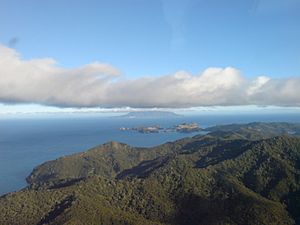
Māori lived on Little Barrier Island for hundreds of years before Europeans arrived. The first Māori settlers were likely descendants of Toi te Huatahi. Later, the Tainui people lived there, followed by the Ngāti Wai tribe.
By 1881, only a few Ngāti Wai people remained on the island. The British Crown tried to buy the island to make it a nature reserve. When the purchase didn't happen, the government took control of the island through a special law in 1894. It became New Zealand's first nature reserve the next year. Some Māori, like Rahui Te Kiri, were asked to leave the island in 1896.
Since 1897, there has always been a caretaker or ranger living on the island. In 2011, the government settled past agreements with local Māori tribes. Hauturu was given back to the tribes, who then gave it back to all the people of New Zealand.
Access to the island is very limited to protect its nature. Only conservation staff, scientists, and rangers from the Department of Conservation live there for short periods. They used to get electricity from a diesel generator. But since 2005, they use twenty solar panels, with the generator only as a backup. This new system saves a lot of fuel and money.
Ancient Stonework
Māori people built stone structures in fourteen different places on the island. Most of these are found on the flat coastal areas at Te Titoki Point. Some old carvings in the rocks, which were used to pull canoes, can still be seen there.
There are also long rows of stones, up to 60 meters (200 feet) long, 2 meters (6.5 feet) wide, and 0.5 meters (1.6 feet) high. These are near the mouth of Te Waikohare Stream. More stone rows and piles are found a bit further from the mouths of Te Waikohare and Tirikawa Streams. The biggest stone pile is 2 meters (6.5 feet) high and 4 meters (13 feet) wide.
The most extensive stonework is in the northwest part of the island, near Te Hue Stream. This area has many terraces with stone walls. There are also many stone piles and rows, and some freestanding stone walls. The stonework in the northeast of the island looks older because it is more worn down and partly buried.
Island Geography
Little Barrier Island is an old, inactive stratovolcano, which is a cone-shaped volcano. It's about 6 kilometers (3.7 miles) wide and covers an area of 28 square kilometers (10.8 square miles). The volcano first became active about 3 million years ago and stopped about 1.2 million years ago.
The island is very steep, with deep valleys that spread out from a central mountain range. The highest point is Mount Hauturu, which is 722 meters (2,369 feet) high. Te Titoki Point is the only flat area on the island.
Island Environment
Little Barrier Island is covered in thick forest. This forest is home to many rare or endangered animals. The island has about 400 different kinds of native plants. It might even have more endangered birds than any other island in New Zealand.
BirdLife International has named the island an Important Bird Area. This is because it's a nesting place for vulnerable Cook's and Parkinson's petrels. In 2013, it was reported that the very rare New Zealand storm petrel was breeding on the island. Kakapo (night parrots), which are also critically endangered, were brought back to the island in 2012. By 2017, there were 14 kakapo living there.
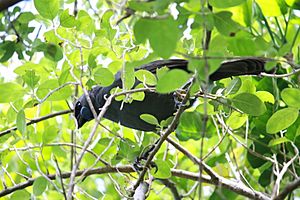
When Māori lived on the island, they cleared about a third of the forest. However, since the New Zealand government took over, almost all of the island has been reforested.
In the waters around the island, you can find Bryde's whales, Orcas (killer whales), and Bottlenose dolphins. Large whales like Blue whales and Southern right whales also rest in this area during their migrations. In 2012, a southern right whale might have given birth near the island.
Invasive Species
Invasive species are plants or animals that are not native to an area and can harm the local environment.
Mammals
- Pacific rats (kiore): These rats were likely brought to the island by Māori settlers. They were removed from the island in 2004 using poison baits dropped from the air.
- Feral cats: Wild cats arrived on the island in the early 1870s. These cats hunted small native animals, like birds and reptiles, which were not used to predators. This caused many native species to become endangered or disappear. Scientists believe the cats affected birds like the North Island snipe, North Island saddleback, and different types of petrels. A special team worked from 1977 to 1980 to remove the cats. They used traps and poison, and 151 cats were removed.
Insects
Several types of introduced wasps are found on the island, including German, Common, Asian Paper, and Tasmanian paper wasps. In some years, there are so many wasps that they become a big problem.
Plants
Before 1995, not much attention was paid to unwanted plants (weeds) on the island. Exotic plants from the rangers' garden and seeds carried by birds or wind were spreading quickly. In 1996, a program started to control these weeds. Teams searched the island to remove them. The main target weeds were Climbing Asparagus, Mexican Devil, and Mist Flower.
See also
 In Spanish: Little Barrier Island para niños
In Spanish: Little Barrier Island para niños


